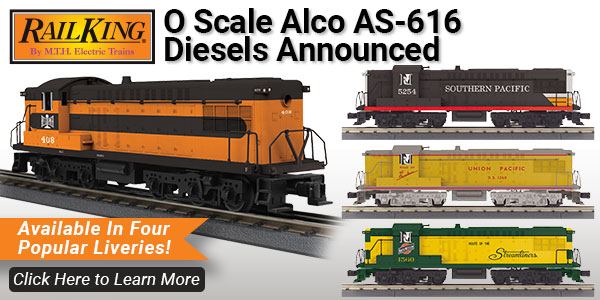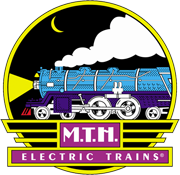Available Items

2021 RailKing AS-616 Diesel Locomotives Announced
July 27, 2021 - M.T.H. Electric Trains will be releasing several limited-edition releases of the RailKing AS-616 Diesel Locomotives in a total of four different liveries later this Fall. These unique releases are expected to arrive in December 2021.
Built from 1950-1954, the AS-616 was Baldwin's best-selling and final stab at the burgeoning road switcher market, which had been pioneered by Alco's RS-1 and came to be dominated by EMD's GP7 and GP9. In theory - and in practice with EMD Geeps - a road switcher was the perfect all-around diesel, equally adept at low-speed yard work or hustling mainline freight. And indeed, AS-616 stood for "All-Service, 6 axle, 1600 horsepower" But the AS-616, like all Baldwin diesels, became typecast by its owners in one particular role: low-speed lugging of heavy loads, both in the yard and in mainline drag freight service.
This role stemmed from the De La Vergne diesel motors that powered all Baldwin units. Acquired by Baldwin in 1931, the De La Vergne Engine Company had started life in 1880 making mechanical refrigeration machines for breweries. Its power plant for Baldwin's locomotives was unique among diesels of its time. In order to make the fuel burn slower and give their 4-cycle engine a longer power stroke, De La Vergne's designers used massive cylinders more than a foot in diameter and added a separate combustion chamber above each cylinder. To allow the fuel more time to burn, they ran the engine at a maximum speed of 625 rpm - just over half the speed of most competitive diesels. In the October 1936 issue of Baldwin Locomotives Magazine, the company claimed that "slow combustion gives low fuel consumption, absence of smoke, quick pick-up, and smooth idling."
Ultimately the massive De La Vergne motor proved to be both a blessing and a curse. Teamed up with equally heavy-duty traction motors supplied by Westinghouse, Baldwin's prime mover found its niche in low-speed, heavy tonnage lugging assignments, where engine crews admired Baldwin diesels because they just wouldn't quit. But those were just the types of assignments in which crews tended to abuse equipment and push an engine to its limits. As a result, Baldwin engines eventually developed a reputation for high maintenance costs. The early VO-1000 switcher, with its normally aspirated 8-cylinder engine, was one of Baldwin's most dependable locomotives; but the turbocharged models that succeeded it, including the AS-616, were plagued by problems that included excessive piston wear and chronic oil leaks. In the early 1950s, when diesel power was new and railroads were trying engines from all manufacturers, 19 U.S. and Latin American railroads purchased 221 AS-616s (including 7 cabless B-units). But by the middle of the decade, it was clear that Baldwin was no longer a contender in the diesel business, and in 1956 the nation's oldest locomotive builder threw in the towel.
Check out each of the schemes in the list on the left.
Product Features
- Intricately Detailed, Durable ABS Body
- Die-Cast Truck Sides, Pilots and Fuel Tank
- Metal Chassis
- Metal Handrails and Horn
- (2) Handpainted Engineer Cab Figures
- Authentic Paint Scheme
- Metal Wheels, Axles and Gears
- (2) Remote-Controlled Proto-Couplers
- Prototypical Rule 17 Lighting
- Directionally Controlled Constant Voltage LED Headlights
- Lighted LED Cab Interior Light
- (2) Precision Flywheel-Equipped Motors
- Operating ProtoSmoke Diesel Exhaust
- Onboard DCC/DCS Decoder
- Locomotive Speed Control In Scale MPH Increments
- 1:48 Scale Proportions
- Proto-Sound 3.0 With The Digital Command System Featuring Freight Yard Proto-Effects
- Unit Measures: 14 1/2” x 2 1/2” x 3 3/4”
- Operates On O-31 Curves











